Ragnarok: The Twilight of the Gods
The story of Ragnarok is written in the Poetic Edda, and it's the end of the world for the Norse gods.
The gods are fighting against the giants and the forces of chaos, led by Loki. He gets his brother, Odin, to eat his own children, who are still alive in their mother's womb. This causes Odin to lose some of his power.
Odin sends a messenger to see if he can get help from someone else. The messenger comes back with a response from Hela (the goddess of death), saying that she'll help them if they give her dominion over the earth. Odin agrees but he doesn't say anything about Hela getting dominion over all of heaven as well (which was what she was really after).
At Ragnarok, everyone dies except for these two people: Lif and Lifthrasir (or Lif and Lifa), who live in an underground cave and eat only morning dew until Ragnarök is over; then they emerge and repopulate the Earth.
What Norse event means twilight of the gods?
The Twilight of the Gods is a Norse myth that predicts the end of the world. The myth tells of how the gods Odin, Thor, Loki, and Freyr will die as a result of Ragnarok, a worldwide catastrophe caused by a great fire and an immense battle between giants and gods.
The Norse believed that Ragnarok will happen during their modern day (between 1700-1900 AD). They also believe that this is foreshadowed by natural disasters such as earthquakes and floods, which are already happening today.
During Ragnarok, three other major events will happen:
The gods will go to war against each other
The Earth will be destroyed by fire or ice (depending on what myth you're reading)
Surtur releases his sword from its sheath and burns everything to ashes
The Prophecy of Ragnarok: The Six Plains, the Nine Worlds and other important things you need to know about it.
Ragnarok is an event in Norse mythology that foreshadows the end of the world. Its name means "fate of the gods," and it is important to remember this when you're deciding how you want to approach the battlefield. In Norse mythology, there are nine worlds that we can be divided into three groups: three worlds of gods (Asgard, Vanaheim and Alfheim), three worlds of giants (Jotunheim, Niflheim, Hel) and three worlds of humans (Midgard, Svartalfheim and Jötunheim). We will be focusing on Asgard, Midgard and Jötunheim since they're the ones with most importance in terms of Ragnarok. Asgard is where all the gods live. It is a realm where they can be at peace while they rest from their many travails. This realm is home to Valhalla, a great hall ruled over by Odin where half of the fallen heroic dead reside after battle. This place serves as a great source of power for Odin due to the fact that he commands his einherjar warriors whose souls reside within it after their deaths. Though not all heroes that die go there as some are to be taken by valkyries to Freyja's hall
The Traitors of Ragnarok – Who Betrayed the Gods?
Everyone knows the story of Ragnarok. The gods are betrayed by their strongest allies and killed by the giants and monsters they created. But who were these traitorous eleven? That's where the argument starts, as every culture has a different list of traitors. Some people say that Loki, who is actually related to the gods, counts for two because he betrays his own brother and father. Others say that Surtur, a giant but also a god, doesn't count because he's a monster first and a god second. And what about Hrym, who is technically part of Jötunheimr (the land of the giants), but is counted by some as one of the gods' betrayers because he's said to be in league with Loki? Some say that no one really betrayed the gods—that they all died together fighting their enemies. Perhaps it was just inevitability on the part of Odin to sacrifice his kin if it meant saving mankind. But there's no denying that many gods didn't make it out alive—whether they went down fighting or whether they made deals with the enemy to save themselves with their lives intact—and it makes you wonder: did those survivors deserve their fates? Were they traitors after all?
Fenrir: Friend or Foe?
Fenrir, the giant wolf who will devour Odin during Ragnarök, is an ambivalent figure in Norse mythology. His story is often told with deep sympathy for the creatures caught up in the end of the world—in his case, he was a gentle giant who was tricked into being chained up. The Eddic poem "Fenrir's Guilt" relates that, while the gods were constructing their fortress of Asgard, they sent Fenrir to keep three whelps in check. One day while out hunting, a peasant woman came by and made friends with Fenrir. She returned later with her daughter and more food—a practice that continued over time. Eventually, a god grew suspicious and used magic to force Fenrir to admit that he had fallen in love with the woman. The peasant woman offered to help him escape if he would marry her daughter; otherwise, she threatened to reveal him to the gods. He agreed, but at their wedding feast, he put an enchanted fetter on her so that she could not leave his side until Ragnarok. This fetter is sometimes called Gleipnir from its role in binding or trapping Fenrir.
SoRagnarok is the undoing of the world of Asgard. The gods need to fight in order to have a new world formed from their ashes. It's not a joyful event but rather a tragic one, and a necessary one for the eternal cycle.
The story basically is saying, "Even though everything is going to go to shit, you can still survive if you're smart.




Leave a comment